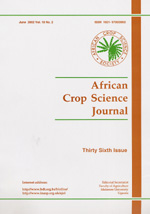
|
African Crop Science Journal
African Crop Science Society
ISSN: 1021-9730
EISSN: 1021-9730
Vol. 7, No. 4, 1999, pp. 479-486
|
 Bioline Code: cs99038
Bioline Code: cs99038
Full paper language: English
Document type: Research Article
Document available free of charge
|
|
|
African Crop Science Journal, Vol. 7, No. 4, 1999, pp. 479-486
| en |
Integrated Management of Major Field Pests of Cowpea In Eastern Uganda
Nampala, P.; Ogenga-Latigo, M.W.; Kyamanywa, S.; Adipala, E.; Karungi, J.; Oyobo1, N.; Obuo, J.E. & Jackai, L.E.N.
Abstract
This study, which was done on-farm and in phases, aimed at developing a farmer and environmentally friendly management package against major cowpea pests. The pests considered were Aphis craccivora, Megalurothrips sjostedti, Maruca vitrata and pod sucking bugs. One trial examined the potential of intercropping in the management of the major field pests of cowpea. Another trial studied the effect of seed dressing and host resistance on cowpea field pest infestation. The best treatments from these two trials were combined (integrated pest management) and tested together with a minimum foliar insecticide application. Intercropping cowpea and sorghum combined with carbofuran "seed dressing" and minimal insecticide spray application (spraying once at budding, flowering and at podding) increased grain yields (ca 1350 kg ha-1) markedly compared to the unsprayed plots (ca 200 kg ha-1), those receiving foliar insecticide spray (ca 1000 kg ha-1) or carbofuran seed dressing only (ca 400 kg ha-1).
Keywords
Grain yield, insecticide sprays, intercropping, seed dressing, Vigna unguiculata
|
| |
| fr |
Nampala, P.; Ogenga-Latigo, M.W.; Kyamanywa, S.; Adipala, E.; Karungi, J.; Oyobo1, N.; Obuo, J.E. & Jackai, L.E.N.
Résumé
Cette étude, qui a été conduite en milièu réel et en phases, visait au développement des packets de gestion contre les principaux pestes du niébe qui sont acceptables par les écologies et les agriculteurs. Les pestes considérés étaient Aphis craccivora, Megalurothrips sjostedti, Maruca vitrata et les punaises suceuses de gousses. Un essai examinait le potential d’association dans le controle de principaux pestes de champs du niébé. Un autre essai a étudié l’effet du traitement de semence et de la résistance de l’hote sur l’infestation de peste de champ du niébé. Les meilleurs traitements de deux essais ont été combinés (gestion intégrée de peste) et testés ensemble avec l’application minimale d’insecticide foliaire. L’association du niébé avec le sorgho combinée avec le traitement de semences au carbofuran et l’application de la pulvérisation minimale d’insecticide (pulvérisation une fois au bourgeonnement, à la floraison et à la formation des gousses) a augmenté le rendements en grains (ca 1350 kg ha-1) remarquablement comparé aux parcelles non pulvérisées (ca 200 kg ha-1), à celles recevant la pulverisation d’insecticide foliaire (ca 1000 kg ha-1) ou le traitement des semences au carbofuran seul (ca 400 kg ha-1).
Mots Clés
Rendement en grains, association, traitement de semences, Vigna unguiculata
|
| |
© Copyright 1999 - African Crop Science Society
|
|
